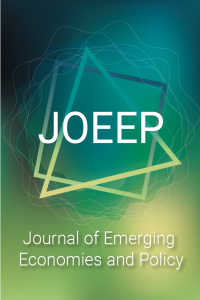Yurt İçi Yerleşiklerin Yabancı Para Mevduatlarının USD Kuruna Etkisi: 1986-2020 Yılları Dolarizasyon Etkileri
Bu çalışmanın amacı, 1986:01-2020:12 dönemi için mevduat dolarizasyonunun ABD dolar kuruna çift yönlü etkisini araştırmaktır. Son yıllarda ülkemizde yoğun bir şekilde tekrar gündeme gelen dolarizasyon olgusu, mevduat dolarizasyonu yönünden ele alınmıştır. Mevduat dolarizasyonu ve ABD dolar kuruna etkisi, liberal ekonomiye geçiş sürecinden sonraki dönemlerden başlamak üzere yurtiçi yerleşik mevduatların ve veri setinin oluşmaya başladığı ilk dönemlerden itibaren günümüze kadar kesintisiz olarak incelenmiştir. Buna göre dolarizasyonun USD kurunu önemli ölçüde etkilediği görülmüştür. USD kurunun dolarizasyon üzerinde herhangi bir etkisi bulunmamıştır. Nedensellik ise tek yönlü olarak saptanmıştır. Mevduat dolarizasyonu ve USD kuru kendi değişimlerinden etkilenmişlerdir. Dolarizasyonun etkisi, onuncu ayın sonunda %15'lik değişim ile kendini göstermiştir.
Anahtar Kelimeler:
Dolarizasyon, Mevduat, Döviz, USD, Döviz kuru
The Effect of Foreign Currency Deposits of Residents on the USD Exchange Rate: The Effects of Dollarization between 1986-2020
This study aims to investigate the bidirectional effect of deposit dollarization on USD exchange rate for the period 1986:01-2020:12. The phenomenon of dollarization, which has been on the agenda again in recent years in our country, has been discussed in terms of deposit dollarization. Deposit dollarization and its effect on the US dollar exchange rate have been studied uninterruptedly, starting from the period after the transition to liberal economy, from the first periods when domestic deposits and the data set began to form, until today. Accordingly, dollarization had a significant effect on USD exchange rate. On the other hand, USD exchange rate was not found to have any effect on dollarization. Therefore, causality was determined to be unidirectional. Their changes influenced deposit dollarization and USD exchange rates. Effect of dollarization showed by the end of the tenth month with 15% of the variation.
Keywords:
Dollarisation, Deposit, Currency, USD, Exchange rate,
___
- Adeniji, S. (2013). Investigating the Relationship between Currency Substitution, Exchange Rate and Inflation in Nigeria: An Autoregressive Distributed Lag (ARDL) Approach. MPRA Paper.
- Akat, A. S. (2000). The political economy of Turkish inflation. Journal of International Affairs, 265-282.
- Akçay, O. C., Alper, C. E., & Karasulu, M. (1997). Currency substitution and exchange rate instability: The Turkish case. European Economic Review, 41(3-5), 827-835.
- Bahmani-Oskooee, M., & Domac, I. (2003). On the link between dollarisation and inflation: Evidence from Turkey. Comparative Economic Studies, 45(3), 306-328.
- Bennett, M. A., Borensztein, M. E., & Baliño, M. T. J. (1999). Monetary policy in dollarized economies: International Monetary Fund.
- Brillembourg, A., & Schadler, S. M. (1979). A model of currency substitution in exchange rate determination, 1973-78. Staff papers, 26(3), 513-542.
- CBRT. (2021). Electronic Data Distribution System (EDDS). (Retrieved: 15.01.2021), from https://evds2.tcmb.gov.tr
- Çetin, A. (2004). Enflasyon, Döviz Kuru Belirsizliği ve Dolarizasyon Arasındaki Nedensellik İlişkisi: Türkiye Örneği. Iktisat Isletme ve Finans, 19(218), 99-110.
- Domac, I., & Bahmani-Oskooee, M. (2002). Between Dollarization and Inflation: Evidence from Turkey: Research and Monetary Policy Department, Central Bank of Turkey.
- Hamilton, J. D. (1994). Time series analysis: Princeton university press.
- Ize, A., & Levy-Yeyati, E. L. (1998). Dollarization of financial intermediation: Causes and policy implications. IMF Working Papers.
- Ize, A., & Powell, A. (2005). Prudential Responses to de facto Dollarization. The Journal of Policy Reform, 8(4), 241-262.
- Johansen, S. (1988). Statistical analysis of cointegration vectors. Journal of economic dynamics and control, 12(2-3), 231-254.
- Johansen, S., & Juselius, K. (1990). Maximum likelihood estimation and inference on cointegration—with applications to the demand for money. Oxford Bulletin of Economics and Statistics, 52(2), 169-210.
- Kearney, C., & Monadjemi, M. (1990). Fiscal policy and current account performance: International evidence on the twin deficits. Journal of Macroeconomics, 12(2), 197-219.
- Lapan, H. E., & Enders, W. (1983). Rational expectations, endogenous currency substitution, and exchange rate determination. The Quarterly Journal of Economics, 98(3), 427-439.
- McKinnon, R. I. (1982). Currency substitution and instability in the world dollar standard. The American economic review, 72(3), 320-333.
- Mohanty, D., & John, J. (2015). Determinants of inflation in India. Journal of Asian Economics, 36, 86-96.
- Özen, A. (2018). Dolarizasyon Olgusu: Teorik Bir İnceleme ve Türkiye Örneği. Ekonomi Politika ve Finans Araştırmaları Dergisi, 3(1), 101-113.
- Ratti, R. A., & Jeong, B. W. (1994). Variation in the real exchange rate as a source of currency substitution. Journal of International Money and Finance, 13(5), 537-550.
- Schuler, K. (1999). Dollarising Indonesia. Bulletin of Indonesian Economic Studies, 35(3), 97-113.
- Selçuk, F. (1994). Currency substitution in Turkey. Applied Economics, 26(5), 509-518.
- Serdengeçti, S. (2005). Dolarizasyon/Ters Dolarizasyon. Ekim: Eskişehir.
- Sever, E. (2012). Türkiye'de Dolarizasyon Süreci ve Döviz Kuru Belirsizliği İlişkisi. Sosyoekonomi, 17(17).
- Wickham, P. (1985). The choice of exchange rate regime in developing countries: A survey of the literature. Staff papers, 32(2), 248-288.
- Yılmaz, M., & Uysal, D. (2019). Türkiye’de Dolarizasyon ve Enflasyon İlişkisi. İktisadi İdari ve Siyasal Araştırmalar Dergisi, 4(10), 286-306.
- Yayın Aralığı: Yılda 2 Sayı
- Başlangıç: 2016
- Yayıncı: Seyfettin ERDOĞAN
Sayıdaki Diğer Makaleler
Enflasyon Hedefinin Yükseltilmesi Makroekonomik Performansı Olumlu Etkiler Mi?
Aslıhan NAKİBOĞLU, Emine Dilara AKTEKİN
COVİD-19 Dezavantajlarına Yönelik Hisse Senedi Oynaklıkları: Ruanda Borsası Örneği
Edouard SINGIRANKABO, Jean Marie Vianney HAKIZIMANA, Jean Paul HAKIZAKUBANA NGOBOKA
Ferit DENİZ, Vahit Ferhan BENLİ
Yönetişim Kalitesi Sahra Altı Afrika Ülkelerinde Vergi Gayretini Etkiliyor mu?
Hamdi Furkan GÜNAY, Mehmet Hanefi TOPAL
Algılanan Hizmet Kalitesinin Tutum Üzerine Etkisinde Hastane Türünün Düzenleyici Etkisi
Emre ÇOLAKOĞLU, İbrahim BOZKURT
Türkiye’de Cari Açık ve Ekonomik Büyüme Arasındaki İlişki
Özcan KARAHAN, Kevser AKÇAÇAKIR
Türkiye’de Gibson Paradoksunun Geçerliliği: Maki Eşbütünleşme Testi
